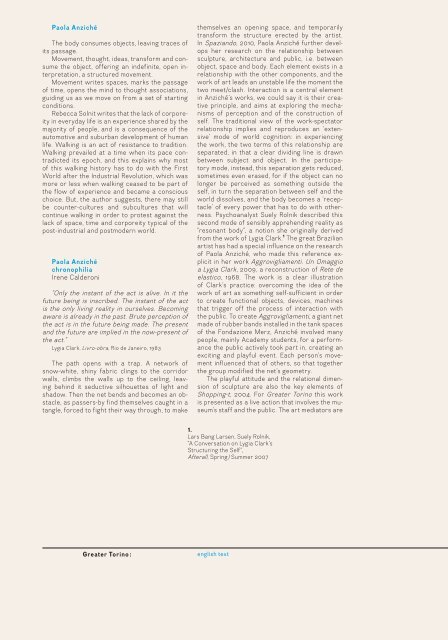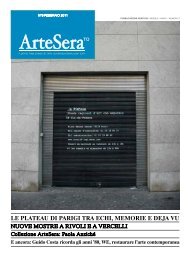Download Catalogue - Paola Anziché
Download Catalogue - Paola Anziché
Download Catalogue - Paola Anziché
Create successful ePaper yourself
Turn your PDF publications into a flip-book with our unique Google optimized e-Paper software.
<strong>Paola</strong> <strong>Anziché</strong><br />
The body consumes objects, leaving traces of<br />
its passage.<br />
Movement, thought, ideas, transform and consume<br />
the object, offering an indefinite, open interpretation,<br />
a structured movement.<br />
Movement writes spaces, marks the passage<br />
of time, opens the mind to thought associations,<br />
guiding us as we move on from a set of starting<br />
conditions.<br />
Rebecca Solnit writes that the lack of corporeity<br />
in everyday life is an experience shared by the<br />
majority of people, and is a consequence of the<br />
automotive and suburban development of human<br />
life. Walking is an act of resistance to tradition.<br />
Walking prevailed at a time when its pace contradicted<br />
its epoch, and this explains why most<br />
of this walking history has to do with the First<br />
World after the Industrial Revolution, which was<br />
more or less when walking ceased to be part of<br />
the flow of experience and became a conscious<br />
choice. But, the author suggests, there may still<br />
be counter-cultures and subcultures that will<br />
continue walking in order to protest against the<br />
lack of space, time and corporeity typical of the<br />
post-industrial and postmodern world.<br />
<strong>Paola</strong> <strong>Anziché</strong><br />
chronophilia<br />
Irene Calderoni<br />
“Only the instant of the act is alive. In it the<br />
future being is inscribed. The instant of the act<br />
is the only living reality in ourselves. Becoming<br />
aware is already in the past. Brute perception of<br />
the act is in the future being made. The present<br />
and the future are implied in the now-present of<br />
the act.”<br />
Lygia Clark, Livro-obra, Rio de Janeiro, 1983<br />
The path opens with a trap. A network of<br />
snow-white, shiny fabric clings to the corridor<br />
walls, climbs the walls up to the ceiling, leaving<br />
behind it seductive silhouettes of light and<br />
shadow. Then the net bends and becomes an obstacle,<br />
as passers-by find themselves caught in a<br />
tangle, forced to fight their way through, to make<br />
Greater Torino :<br />
themselves an opening space, and temporarily<br />
transform the structure erected by the artist.<br />
In Spaziando, 2010, <strong>Paola</strong> <strong>Anziché</strong> further develops<br />
her research on the relationship between<br />
sculpture, architecture and public, i.e. between<br />
object, space and body. Each element exists in a<br />
relationship with the other components, and the<br />
work of art leads an unstable life the moment the<br />
two meet/clash. Interaction is a central element<br />
in <strong>Anziché</strong>’s works, we could say it is their creative<br />
principle, and aims at exploring the mechanisms<br />
of perception and of the construction of<br />
self. The traditional view of the work-spectator<br />
relationship implies and reproduces an ‘extensive’<br />
mode of world cognition: in experiencing<br />
the work, the two terms of this relationship are<br />
separated, in that a clear dividing line is drawn<br />
between subject and object. In the participatory<br />
mode, instead, this separation gets reduced,<br />
sometimes even erased, for if the object can no<br />
longer be perceived as something outside the<br />
self, in turn the separation between self and the<br />
world dissolves, and the body becomes a ‘receptacle’<br />
of every power that has to do with otherness.<br />
Psychoanalyst Suely Rolnik described this<br />
second mode of sensibly apprehending reality as<br />
“resonant body”, a notion she originally derived<br />
from the work of Lygia Clark. 1 The great Brazilian<br />
artist has had a special influence on the research<br />
of <strong>Paola</strong> <strong>Anziché</strong>, who made this reference explicit<br />
in her work Aggrovigliamenti. Un Omaggio<br />
a Lygia Clark, 2009, a reconstruction of Rete de<br />
elastico, 1968. The work is a clear illustration<br />
of Clark’s practice: overcoming the idea of the<br />
work of art as something self-sufficient in order<br />
to create functional objects, devices, machines<br />
that trigger off the process of interaction with<br />
the public. To create Aggrovigliamenti, a giant net<br />
made of rubber bands installed in the tank spaces<br />
of the Fondazione Merz, <strong>Anziché</strong> involved many<br />
people, mainly Academy students, for a performance<br />
the public actively took part in, creating an<br />
exciting and playful event. Each person’s movement<br />
influenced that of others, so that together<br />
the group modified the net’s geometry.<br />
The playful attitude and the relational dimension<br />
of sculpture are also the key elements of<br />
Shopping-t, 2004. For Greater Torino this work<br />
is presented as a live action that involves the museum’s<br />
staff and the public. The art mediators are<br />
1.<br />
Lars Bang Larsen, Suely Rolnik,<br />
“A Conversation on Lygia Clark’s<br />
Structuring the Self”,<br />
Afterall, Spring / Summer 2007<br />
english text



